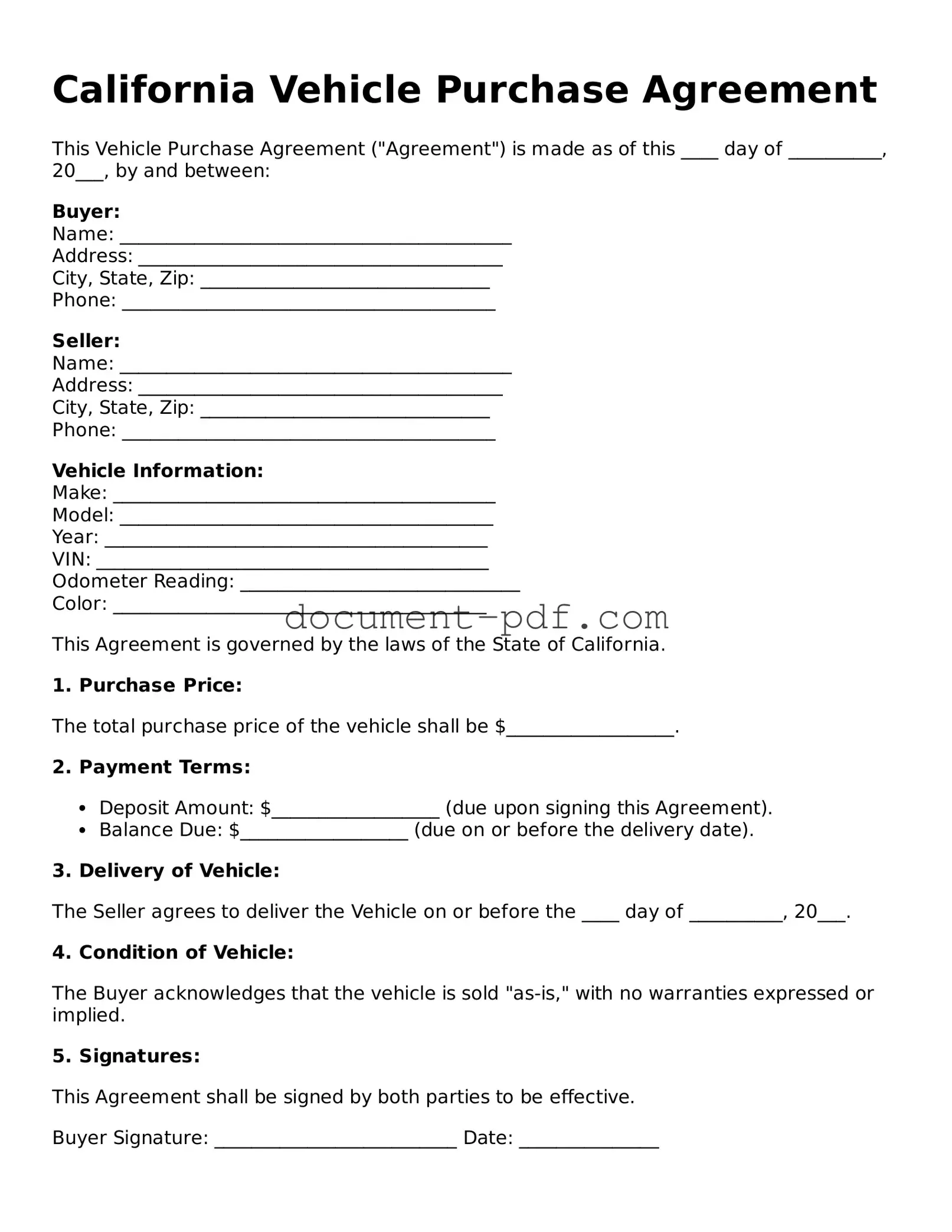The California Vehicle Purchase Agreement form is similar to the Bill of Sale, which serves as a legal document that transfers ownership of a vehicle from the seller to the buyer. Like the Vehicle Purchase Agreement, the Bill of Sale outlines essential details such as the vehicle's make, model, and identification number, as well as the purchase price. Both documents aim to provide proof of the transaction and protect the interests of both parties involved.
Another document that resembles the California Vehicle Purchase Agreement is the Vehicle Title. The Vehicle Title is a legal document issued by the state that establishes ownership of a vehicle. While the Vehicle Purchase Agreement is a record of the sale, the Vehicle Title is necessary for registering the vehicle in the new owner's name. Both documents are crucial in ensuring a clear transfer of ownership and can be required during the registration process.
The Purchase Order is also similar to the Vehicle Purchase Agreement. This document outlines the terms of a sale, including price, quantity, and delivery details. In the context of vehicle purchases, it provides a formal record of the buyer's intent to purchase, much like the Vehicle Purchase Agreement. Both documents help to clarify expectations and responsibilities for both the buyer and seller.
The Lease Agreement shares similarities with the Vehicle Purchase Agreement, particularly in outlining the terms of use for a vehicle. While the Vehicle Purchase Agreement pertains to outright ownership, a Lease Agreement details the terms under which a vehicle can be used for a specified period. Both documents include information about payments, responsibilities, and conditions, ensuring that both parties are aware of their obligations.
Another related document is the Financing Agreement. This document outlines the terms of any loans or financing arrangements made to purchase a vehicle. Like the Vehicle Purchase Agreement, it details the buyer's obligations, including payment amounts and schedules. Both documents work together to ensure that the buyer understands their financial commitments and the implications of the vehicle purchase.
The Odometer Disclosure Statement is also closely related to the Vehicle Purchase Agreement. This document records the mileage of the vehicle at the time of sale, ensuring transparency and protecting against fraud. Both the Odometer Disclosure Statement and the Vehicle Purchase Agreement are often required during the sale process to provide accurate information about the vehicle's condition and history.
The Warranty Document is another important paper that aligns with the Vehicle Purchase Agreement. This document outlines any guarantees or promises made by the seller regarding the vehicle's condition and performance. While the Vehicle Purchase Agreement confirms the sale, the Warranty Document provides assurance to the buyer about the vehicle's reliability, thus enhancing trust in the transaction.
In the realm of estate planning, having a solid understanding of various documentation can greatly benefit individuals in managing their assets. Among these important documents is a Last Will and Testament form, which allows individuals to express their final wishes regarding asset distribution. By ensuring that this document is properly executed, one can facilitate a smoother transition for their beneficiaries, mitigating potential conflicts and misunderstandings.
The Inspection Report can also be compared to the Vehicle Purchase Agreement. This document provides a detailed assessment of the vehicle's condition prior to sale. Like the Vehicle Purchase Agreement, it serves to inform the buyer about the vehicle's status and can influence their decision to purchase. Both documents are essential in ensuring that the buyer is fully informed before completing the transaction.
Lastly, the Insurance Policy Document is similar to the Vehicle Purchase Agreement in that it is crucial for protecting the buyer's investment. While the Vehicle Purchase Agreement confirms the sale, the Insurance Policy provides coverage against potential damages or liabilities. Both documents work in tandem to ensure that the buyer is safeguarded during and after the purchase process.
